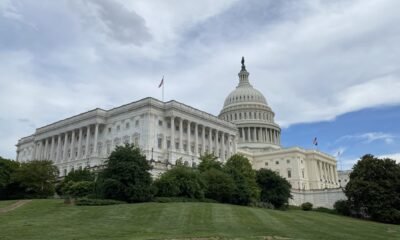Business
Uhlich Demands RTA Update as Draft Plan Heads to Public Review; School Boards Explore System Changes

Tucson City Council member Karin Uhlich has initiated a request for a study session to discuss the Regional Transportation Authority’s (RTA) upcoming funding round and the potential involvement of Tucson. This conversation is crucial as it revolves around the RTA Next plan, which seeks funding through a renewed 20-year, half-cent sales tax.
The decision carries weight since Tucson’s participation is vital to the success of this eight-jurisdiction transportation plan, which could bring in as much as $3 billion over two decades. Currently, the City Council remains undecided on the matter, having previously remained noncommittal.
Recently, the RTA board opted to present a draft plan to the public to assess community support for the initiative ahead of a potential election in November 2025. In a noteworthy concession, the board has promised to allocate approximately 80 percent of additional revenue to city projects, addressing Tucson’s grievances about its fair share of funds generated within its limits.
This promise stems from the RTA’s cautious revenue forecasting, a reaction to the financial setbacks experienced during the Great Recession, which has made resource allocation challenging among local governments. Tucson’s council members have expressed frustration regarding the perceived inequity in revenue distribution, feeling that the RTA’s upper management has not treated city leaders with sufficient respect.
A compromise proposed by RTA Board Chairman Ted Maxwell ensures Tucson receives 55 percent of revenues, contingent on exceeding these pessimistic revenue estimates. Although this figure is below the desired two-thirds, it aligns more closely with Tucson’s proportional share of Pima County’s total population.
With Tucson’s cooperation essential, the scenario presents potential political risks for the council members if they reject the plan after public engagement. Council members, as public representatives, are urged to clarify their positions ahead of this crucial decision.
Uhlich, drawing from her experience in the RTA’s initial election, emphasizes the need for constructive dialogue rather than complaints. Mayor Regina Romero and Councilmember Paul Cunningham have echoed that progress should only proceed with unanimous council support, granting each member veto power.
In an interesting twist, Uhlich’s recent appointment, filling Steve Kozachik’s term, may limit her capacity to influence the larger plan significantly. Still, her veteran status allows her to pivot discussions toward a collaborative resolution.
The need for regional collaboration is underscored by various challenges Tucson faces, including housing shortages and economic development. For example, the city’s Northwest Side is witnessing a housing boom, contrasting with the rising unaffordability in Midtown. Understanding the transportation needs of low-wage workers who live outside Tucson is paramount as they navigate their commutes.
Additionally, increasing density in residential areas can lead to higher crime rates, raising concerns about public safety in neighboring communities. These multifaceted issues demand regional cooperation, especially as they relate to critical resources such as water and climate action strategies.
The City Council will also receive updates on Tucson’s climate action plan, dubbed “Resilient Together,” which aims to enhance heat relief measures by collaborating with various stakeholders ahead of summer 2024. City staff will present a highlight of their success in securing $16.1 million for shade initiatives, aimed at combatting the harsh summer heat.
Moreover, Tucson has made significant strides in urban forestry, planting 120,000 trees within four years, aiming for a total of one million trees by 2054. Alongside these environmental efforts, the city is investigating the origin of its municipal energy sources to transition towards cleaner energy alternatives.
In addressing homelessness, Tucson’s proposed People, Communities and Homes Investment Plan seeks to secure funding from the U.S. Department of Housing and Urban Development. This initiative stands apart from the city’s internal housing strategies, focusing on improving opportunities and combating substance abuse.
Despite ambitious goals, Tucson faces a stark housing supply crisis. From the mid-1950s to the mid-2000s, the area saw the construction of approximately 30,000 homes every decade. However, between 2013 and 2023, only 4,400 homes were built, starkly illustrating the region’s challenges.
While demographic shifts are yielding increased income levels, the rising demand for housing amidst limited supply complicates the landscape. Notably, the median household income among Latinos has surged from just under $24,000 to nearly $54,000 within a decade, while Native populations also experienced significant gains in earnings.
Yet, issues persist, as African American and Asian American incomes have plateaued since 2018, reflecting broader socioeconomic disparities. The South Side, often associated with poverty, is witnessing a service void rather than a high concentration of poverty, which is now largely concentrated in areas north of Speedway.
In upcoming City Council actions, a vote will also take place concerning amendments to ordinances related to construction rules for Accessory Dwelling Units (ADUs), commonly known as casitas. Recent state legislation mandates significant changes to local regulations, allowing for greater flexibility in constructing these units.
During Tuesday’s meeting, the Catalina Foothills Unified School District Governing Board will discuss a contract worth $519,670 for a crisis alert system aimed at empowering school personnel to respond to various emergencies. Meanwhile, the Amphitheater Unified School District will provide insights into its preventative maintenance strategy and address its repair backlog.
In the Vail Unified School District, board members will review a policy book update from the Arizona School Board Association, establishing compliance with new education mandates. This administrative effort highlights the ongoing adjustments necessary for local schools to align with state regulations while delivering quality education.


![Members of the Arizona House of Representatives vote during a third reading of nearly three dozen bills at the Arizona State Capitol on March 4, 2025. [Monica D. Spencer]](https://arizonanews.org/wp-content/uploads/2025/06/SR-347-Secures-53M-in-Third-State-Budget-Draft-Awaiting-400x240.jpg)
![Members of the Arizona House of Representatives vote during a third reading of nearly three dozen bills at the Arizona State Capitol on March 4, 2025. [Monica D. Spencer]](https://arizonanews.org/wp-content/uploads/2025/06/SR-347-Secures-53M-in-Third-State-Budget-Draft-Awaiting-80x80.jpg)














